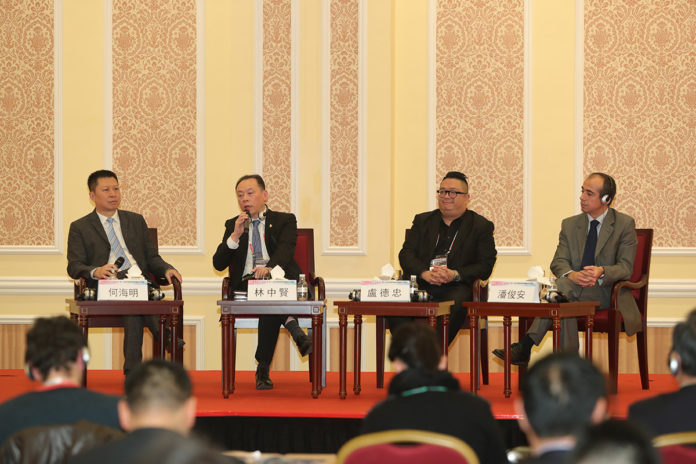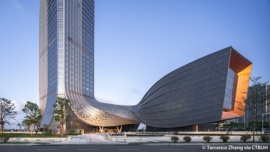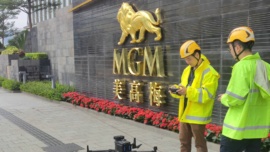Increased interconnectivity, data analysis, and environmentally friendly policies will help the MICE (Meetings, Incentives, Conventions and Exhibitions) sector in Macau reduce costs and increase attendance, according to leading members of the sector.
According to the President of the Macau Fair and Trade Association, Tony Lam, and the President of Macau Amusing Grand Events Promotion Association, Lo Tak Chong, the low number of resources and limited area make Macau the perfect place for developing technologies and methods that allow more effective event management.
“Macau has limited resources for MICE, so in order to really develop in this industry we want to use green energy and technology to improve the industry,” said Lam.
The statements were made at the Macau MICE Industry – Road to Innovation conference that took place on Friday, as part of the 13th China Expo Forum for International Cooperation (CEFCO 2017) held from January 12 to 14 at The Venetian.
Green and efficient
Sustainability of MICE events has been one of the missions pursued by Tony Lam, who commented that since 2007 the Macau Fair and Trade Association has gathered environmental data on large exhibitions held in the MSAR so as to develop “green booths”.
This led to the creation of a scheme to establish green standards and guidelines for booth construction, and develop a reward system to encourage this practice, resulting in the launch of the “Green Booth Award” and the “Electricity Free Rebate Scheme” at the 2010 Macau International Environmental Co-operation Forum and Exhibition (MIECF). The schemes rate the sustainability of the convention booths.
“We wanted to dispel the misconception that environmental pro-action is equal to cost increase, and hoped these initiatives would encourage organisers, exhibitors and contractors to develop green conventions and exhibitions,” stated Lam.
Soon after the initial initiatives, others started appearing, by exhibitors, such as using water-based inkjets for decoration, environmentally friendly carpets, and donating booth materials to NGO’s for re-use. A total of 500 awards were handed out for these initiatives in 2016.
According to Mr. Lam, since its implementation at the convention, the scheme has led to a 75 per cent reduction in waste, a 40 per cent increase in the ratio of light-saving equipment and a 40 per cent rise in recycled material equipment, as of 2015.
Demand for garbage trucks for the event was also reduced from 102 trucks in 2008 to 25 in 2015, he notes.
Technology handicaps
For Bruno Simões, Secretary of the Macau Meetings, Incentives and Special Events Association (MISE) and Managing Director of local event company DOC DMC, natural technological developments have already helped cut costs and make the sector more sustainable and efficient.
“We don’t do paper mail and brochures anymore, everything is by email as communication has shifted to digital. This will be more predominant in the future as events will be more and more digital, with everyone having smartphones and an Internet connection,” stated Simões.
For the event planning businessman, technology is already an essential part of how to engage delegates, create pre-event ‘buzz’ and promote the delegates, while helping participants interact and network.
“Interaction is important and technological integration is, a lot of the time, promised but rarely delivered. There needs to be a good integration, with the internet of things (IoT) with phones, tablets and computers being all interconnected during the event. However people don’t like to download an event app that they will only use for a day, so offer apps that offer long term engagement for post-event features,” stated Mr. Simões.
Target audience
Studying your event’s target audience and ensuring the exhibition caters to that segment’s interests are also core values for event organising – a sentiment both Simões and Lo Tak Chong share.
According to the President of the Macau Amusing Grand Events Promotion Association, five years ago his company, MACEXPO Exhibition Co. Ltd, discovered that most exhibition visitors were from Mainland China, while young people in Macau weren’t as interested in exhibitions.
“We needed to offer good branding for our exhibitions. If the theme is for young people we try to have some fun and sporty elements and promote them through online and offline campaigns. Shareable contents on Facebook act as starting points for the event image promotion, and live streaming allows us to get directly to all our followers,” Lo pointed out.
Lo praised the potential of artificial intelligence (AI) systems for collecting data from customers and personalising promotional campaigns.
“AI is already happening, in Google and Facebook. In the future you will see your target audience’s search habits and search history being analysed and used for targeted advertising, and you will be able to ask AI systems to send information to your target audience,” stated Mr. Lo.
Big data will also have a role in reducing the environmental impact of exhibitions, according to Tony Lam, providing important details on MICE events planning, and through data sharing with other Pearl River Delta cities to reduce carbon emissions and material waste.
When asked if communication technology developments would make physical events and conferences redundant and unnecessary in the future, Mr. Simões stated that although such advancements would increase speed and efficiency “the need for physical conferences” won’t disappear “just because Skype and live conferences exist”.
























